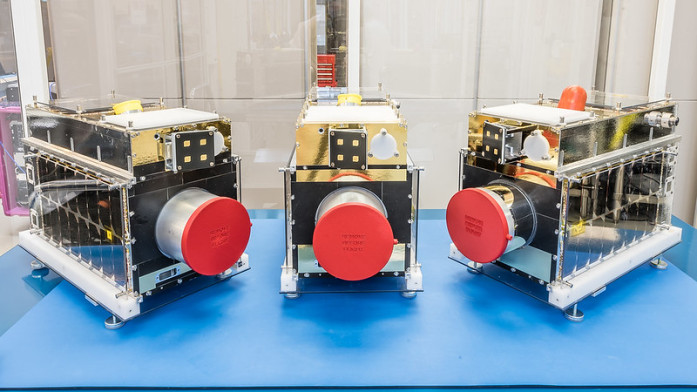This sharp growth will allow GHGSat's pioneering constellation - already the world's largest collection of satellites dedicated to monitoring greenhouse gases - to revisit industrial sites to detect methane emissions on a daily cadence around the world.
BAKU, AZERBAIJAN / ACCESSWIRE / November 11, 2024 / GHGSat, the global leader in satellite emissions monitoring, will rapidly expand its satellite constellation through the launch of nine new satellites, near-doubling its fleet of methane monitoring satellites by the end of 2026.

Three of GHGSat's satellites ahead of their launch on SpaceX in 2022.
This sharp growth will allow GHGSat's pioneering constellation - already the world's largest collection of satellites dedicated to monitoring greenhouse gases - to revisit industrial sites to detect methane emissions on a daily cadence around the world.
As the world gathers for COP29 in Baku, it is increasingly clear that tackling methane emissions is one of the fastest levers the world has to limit warming to the 1.5 degrees Celsius targeted in the Paris Agreement. Because methane has a warming effect roughly 80 times stronger than carbon dioxide over a 20-year period, reducing its levels in the atmosphere can have a swift impact on the climate. In the near-term, every ton of methane reduced will be equivalent to over 100 tons of carbon dioxide reduced over the subsequent five years. Methane alone is responsible for approximately 0.5 degrees Celsius of current warming.
Today, GHGSat's constellation of satellites traces greenhouse gas emissions directly to industrial facilities at an unmatched cadence, arming industry and government decision-makers with data and insights required to tackle greenhouse gas emissions. In 2023 alone, GHGSat's satellite constellation made more than 3 million observations across 85 countries, identifying nearly 16,000 emissions over the super-emitter threshold of 100 kilograms of methane per hour. Since COP28, GHGSat has identified more than 20,000 plumes at this threshold, highlighting the scale of the emissions challenge and need for greater monitoring coverage.
"Industry, governments and financial services are hungry for this data, which fills a critical emissions knowledge gap," said Stephane Germain, CEO and Founder of GHGSat. "Since the launch of GHGSat's first satellite in 2016, we have pinpointed and measured tens of thousands of emissions worldwide. But without the significant number of satellites required to orbit the planet more frequently, we risk merely scratching the surface of the true extent of global emissions. With this rapid scale-up, GHGSat will unlock a level of detail about greenhouse gas emissions that was previously unimaginable."
As part of the expansion, GHGSat is working with a group of long-standing partners, all renowned and world-class space and manufacturing companies, to develop and deliver the satellites.
This scale-up is critical to enable carbon-intensive industries to fulfill ambitious methane pledges from previous COPs, such as the Global Methane Pledge announced at COP26 and the Oil and Gas Decarbonization Charter announced at COP28. The Global Methane Pledge counted 158 countries as of March 2024 with the stated ambition of reducing global methane emissions by 30% from 2020 levels by 2030. The Oil and Gas Decarbonization Charter saw the commitment of the world's largest oil and natural gas companies to end routine flaring, reduce upstream methane emissions to near-zero by 2030, and achieve Net Zero emissions from operations by 2050. GHGSat provides robust emissions data and frequent monitoring of assets in support of these initiatives, and many others. As discussions at COP29 seek to turn climate pledges into tangible progress, data will be foundational to understanding the current baseline of emissions and rapidly trace leaks for mitigation action.
Contact Information
Alison Boyer
Director of Communications
aboyer@ghgsat.com
SOURCE: GHGSat
View the original press release on newswire.com.
